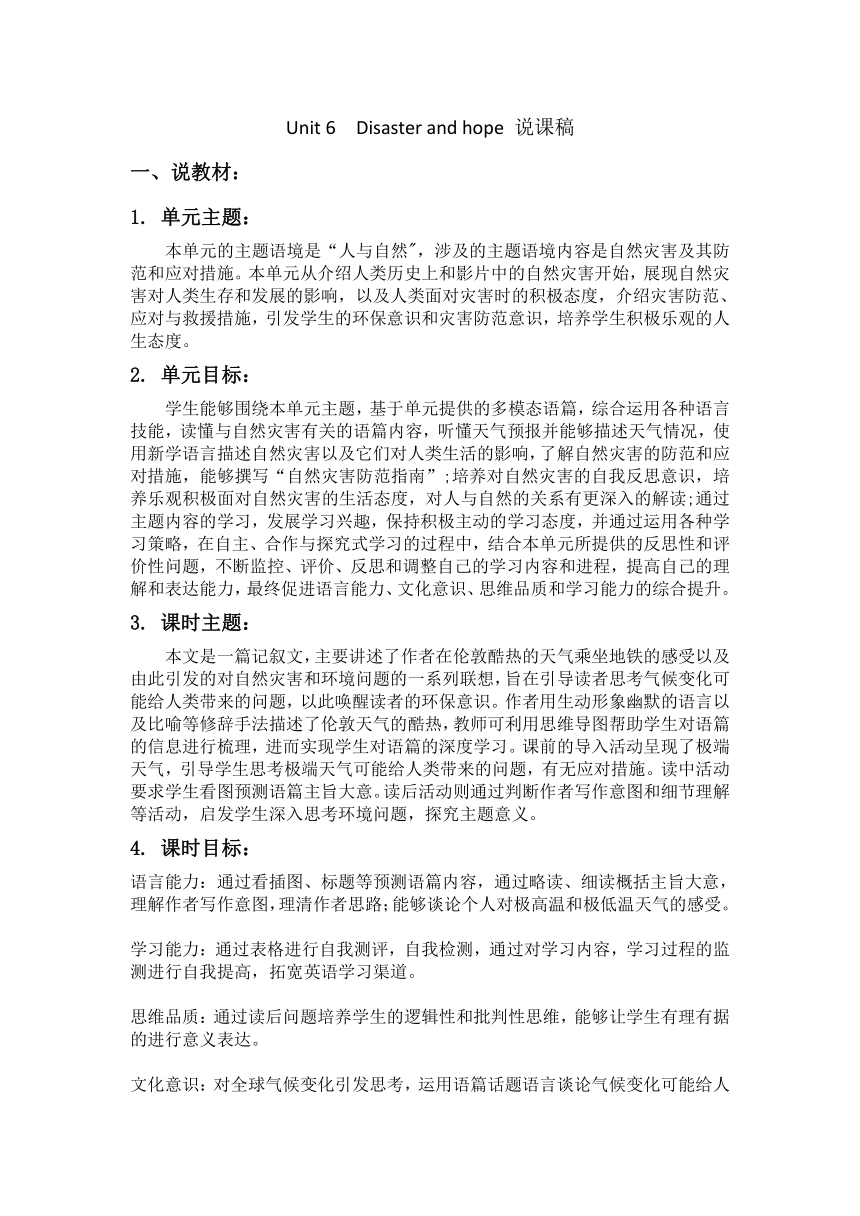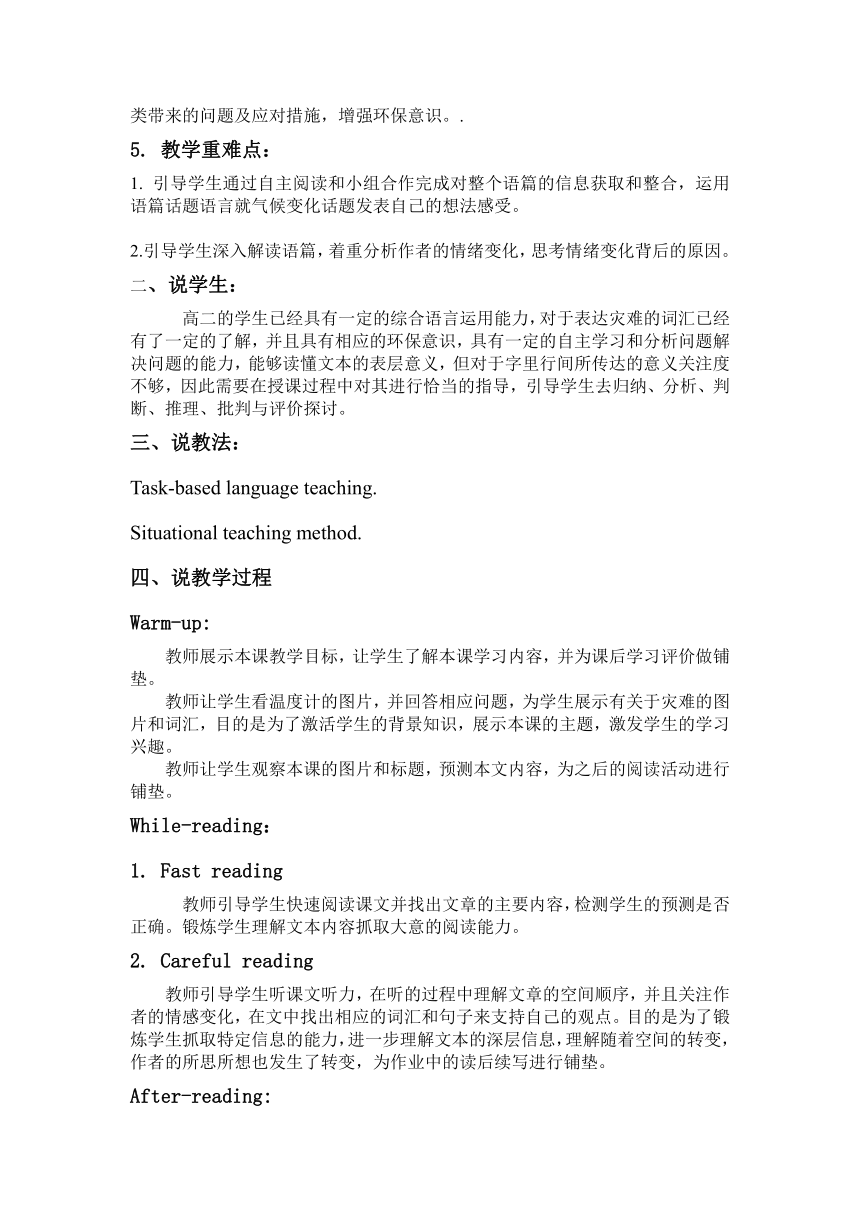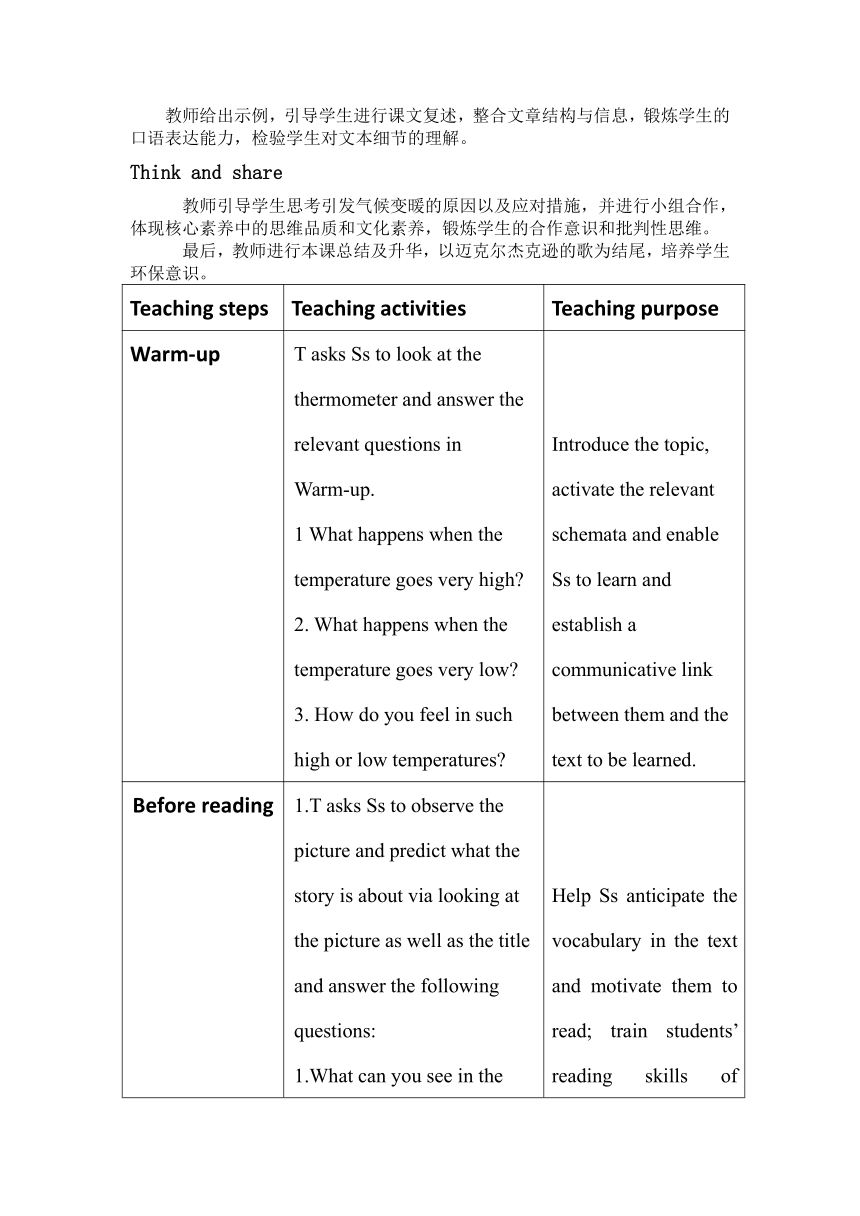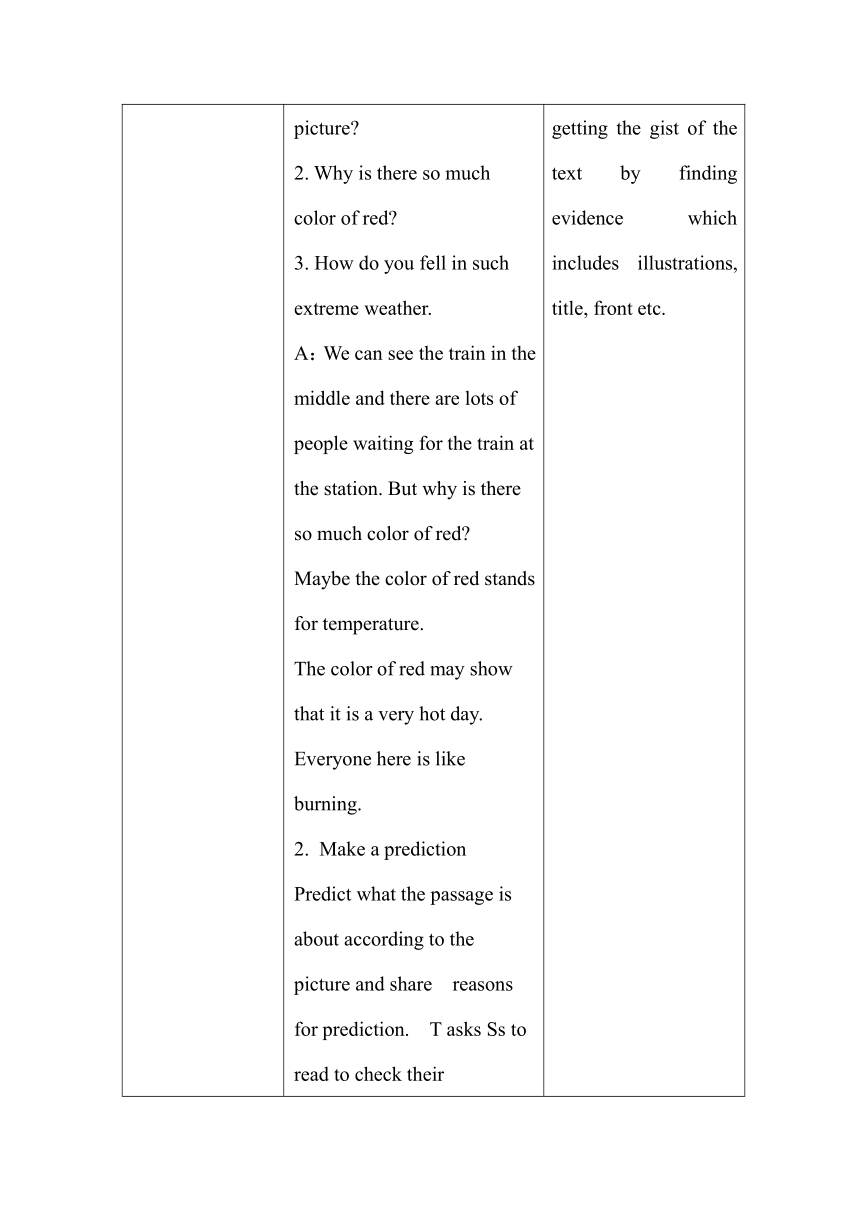外研版(2019)必修 第三册Unit 6 Disaster and hope课时教学示范课说课稿
文档属性
| 名称 | 外研版(2019)必修 第三册Unit 6 Disaster and hope课时教学示范课说课稿 |

|
|
| 格式 | docx | ||
| 文件大小 | 32.2KB | ||
| 资源类型 | 教案 | ||
| 版本资源 | 外研版(2019) | ||
| 科目 | 英语 | ||
| 更新时间 | 2024-03-04 19:55:38 | ||
图片预览




文档简介
Unit 6 Disaster and hope 说课稿
一、说教材:
1. 单元主题:
本单元的主题语境是“人与自然",涉及的主题语境内容是自然灾害及其防范和应对措施。本单元从介绍人类历史上和影片中的自然灾害开始,展现自然灾害对人类生存和发展的影响,以及人类面对灾害时的积极态度,介绍灾害防范、应对与救援措施,引发学生的环保意识和灾害防范意识,培养学生积极乐观的人生态度。
单元目标:
学生能够围绕本单元主题,基于单元提供的多模态语篇,综合运用各种语言技能,读懂与自然灾害有关的语篇内容,听懂天气预报并能够描述天气情况,使用新学语言描述自然灾害以及它们对人类生活的影响,了解自然灾害的防范和应对措施,能够撰写“自然灾害防范指南”;培养对自然灾害的自我反思意识,培养乐观积极面对自然灾害的生活态度,对人与自然的关系有更深入的解读;通过主题内容的学习,发展学习兴趣,保持积极主动的学习态度,并通过运用各种学习策略,在自主、合作与探究式学习的过程中,结合本单元所提供的反思性和评价性问题,不断监控、评价、反思和调整自己的学习内容和进程,提高自己的理解和表达能力,最终促进语言能力、文化意识、思维品质和学习能力的综合提升。
课时主题:
本文是一篇记叙文,主要讲述了作者在伦敦酷热的天气乘坐地铁的感受以及由此引发的对自然灾害和环境问题的一系列联想,旨在引导读者思考气候变化可能给人类带来的问题,以此唤醒读者的环保意识。作者用生动形象幽默的语言以及比喻等修辞手法描述了伦敦天气的酷热,教师可利用思维导图帮助学生对语篇的信息进行梳理,进而实现学生对语篇的深度学习。课前的导入活动呈现了极端天气,引导学生思考极端天气可能给人类带来的问题,有无应对措施。读中活动要求学生看图预测语篇主旨大意。读后活动则通过判断作者写作意图和细节理解等活动,启发学生深入思考环境问题,探究主题意义。
课时目标:
语言能力:通过看插图、标题等预测语篇内容,通过略读、细读概括主旨大意,理解作者写作意图,理清作者思路;能够谈论个人对极高温和极低温天气的感受。
学习能力:通过表格进行自我测评,自我检测,通过对学习内容,学习过程的监测进行自我提高,拓宽英语学习渠道。
思维品质:通过读后问题培养学生的逻辑性和批判性思维,能够让学生有理有据的进行意义表达。
文化意识:对全球气候变化引发思考,运用语篇话题语言谈论气候变化可能给人类带来的问题及应对措施,增强环保意识。.
教学重难点:
引导学生通过自主阅读和小组合作完成对整个语篇的信息获取和整合,运用语篇话题语言就气候变化话题发表自己的想法感受。
2.引导学生深入解读语篇,着重分析作者的情绪变化,思考情绪变化背后的原因。
二、说学生:
高二的学生已经具有一定的综合语言运用能力,对于表达灾难的词汇已经有了一定的了解,并且具有相应的环保意识,具有一定的自主学习和分析问题解决问题的能力,能够读懂文本的表层意义,但对于字里行间所传达的意义关注度不够,因此需要在授课过程中对其进行恰当的指导,引导学生去归纳、分析、判断、推理、批判与评价探讨。
三、说教法:
Task-based language teaching.
Situational teaching method.
说教学过程
Warm-up:
教师展示本课教学目标,让学生了解本课学习内容,并为课后学习评价做铺垫。
教师让学生看温度计的图片,并回答相应问题,为学生展示有关于灾难的图片和词汇,目的是为了激活学生的背景知识,展示本课的主题,激发学生的学习兴趣。
教师让学生观察本课的图片和标题,预测本文内容,为之后的阅读活动进行铺垫。
While-reading:
Fast reading
教师引导学生快速阅读课文并找出文章的主要内容,检测学生的预测是否正确。锻炼学生理解文本内容抓取大意的阅读能力。
Careful reading
教师引导学生听课文听力,在听的过程中理解文章的空间顺序,并且关注作者的情感变化,在文中找出相应的词汇和句子来支持自己的观点。目的是为了锻炼学生抓取特定信息的能力,进一步理解文本的深层信息,理解随着空间的转变,作者的所思所想也发生了转变,为作业中的读后续写进行铺垫。
After-reading:
教师给出示例,引导学生进行课文复述,整合文章结构与信息,锻炼学生的口语表达能力,检验学生对文本细节的理解。
Think and share
教师引导学生思考引发气候变暖的原因以及应对措施,并进行小组合作,体现核心素养中的思维品质和文化素养,锻炼学生的合作意识和批判性思维。
最后,教师进行本课总结及升华,以迈克尔杰克逊的歌为结尾,培养学生环保意识。
Teaching steps Teaching activities Teaching purpose
Warm-up T asks Ss to look at the thermometer and answer the relevant questions in Warm-up. 1 What happens when the temperature goes very high 2. What happens when the temperature goes very low 3. How do you feel in such high or low temperatures Introduce the topic, activate the relevant schemata and enable Ss to learn and establish a communicative link between them and the text to be learned.
Before reading 1.T asks Ss to observe the picture and predict what the story is about via looking at the picture as well as the title and answer the following questions: 1.What can you see in the picture 2. Why is there so much color of red 3. How do you fell in such extreme weather. A:We can see the train in the middle and there are lots of people waiting for the train at the station. But why is there so much color of red Maybe the color of red stands for temperature. The color of red may show that it is a very hot day. Everyone here is like burning. Make a prediction Predict what the passage is about according to the picture and share reasons for prediction. T asks Ss to read to check their predictions. Help Ss anticipate the vocabulary in the text and motivate them to read; train students’ reading skills of getting the gist of the text by finding evidence which includes illustrations, title, front etc.
Fast reading T asks Ss to read the passage quickly to get the main idea and check their predicitons in Activity 1. Test Ss’ understanding of the passage; train Ss’ reading skills of getting the main idea.
Careful reading T asks Ss to listen to the tape and think about in what order this passage is developed. Ss analyze the author’s feelings at different space by finding the supporting words and expressions from the passage, and T draws a mind map to show the change . T asks Ss to complete the flow chart with words and expressions from the passage. Train Ss’ skills of getting specific information and enable Ss to have a deeper understanding of the passage;
After reading Retell T asks Ss to retell the story focusing on the change of the author’s feelings. Encourage Ss to think about the story, evaluate the author’s message and build oral language as they retell.
Think and share 1.T asks Ss to discuss the two questions in groups and offer assistance when necessary. ①. What are the causes of climate change ②. What can we do when facing climate change T introduces The World Earth Day to Ss Train Ss’ ability to use language in their real life and express the ideas in a logical way; develop their critical and creative thinking abilities.
Summary and Homework(分层作业) T summarize what Ss learned in the class. 1. 从课文中找出重点短语及句型进行积累(必做)。 2. 阅读 Stars after the storm 并完成课后的思维导图(Page 90-93 必做)。 3. 读后续写(no less than 80 words 选做): Stepping out of the station with a heavy heart, I suddenly feel a fresh wind on my face. However, simply realizing that climate change is a threat is not enough. 4.Enjoy a song “ Heal the World” . Develop Ss’s skills of continuation writing and strengthen their reading abilities.
五、说作业:
根据学生学习情况的不同将作业分成两类,分别是必做作业以及对学有余力的同学来说选做的作业,其中,作业二是对学考进行准备,作业三则是帮助学生训练读后续写的能力。
1. 从课文中找出重点短语及句型进行积累(必做)。
2. 阅读 Stars after the storm 并完成课后的思维导图(Page 90-93 必做)。
3. 读后续写(no less than 80 words 选做):
Stepping out of the station with a heavy heart, I suddenly feel a fresh wind on my face.
However, simply realizing that climate change is a threat is not enough.
六、自我评价与检测
一、说教材:
1. 单元主题:
本单元的主题语境是“人与自然",涉及的主题语境内容是自然灾害及其防范和应对措施。本单元从介绍人类历史上和影片中的自然灾害开始,展现自然灾害对人类生存和发展的影响,以及人类面对灾害时的积极态度,介绍灾害防范、应对与救援措施,引发学生的环保意识和灾害防范意识,培养学生积极乐观的人生态度。
单元目标:
学生能够围绕本单元主题,基于单元提供的多模态语篇,综合运用各种语言技能,读懂与自然灾害有关的语篇内容,听懂天气预报并能够描述天气情况,使用新学语言描述自然灾害以及它们对人类生活的影响,了解自然灾害的防范和应对措施,能够撰写“自然灾害防范指南”;培养对自然灾害的自我反思意识,培养乐观积极面对自然灾害的生活态度,对人与自然的关系有更深入的解读;通过主题内容的学习,发展学习兴趣,保持积极主动的学习态度,并通过运用各种学习策略,在自主、合作与探究式学习的过程中,结合本单元所提供的反思性和评价性问题,不断监控、评价、反思和调整自己的学习内容和进程,提高自己的理解和表达能力,最终促进语言能力、文化意识、思维品质和学习能力的综合提升。
课时主题:
本文是一篇记叙文,主要讲述了作者在伦敦酷热的天气乘坐地铁的感受以及由此引发的对自然灾害和环境问题的一系列联想,旨在引导读者思考气候变化可能给人类带来的问题,以此唤醒读者的环保意识。作者用生动形象幽默的语言以及比喻等修辞手法描述了伦敦天气的酷热,教师可利用思维导图帮助学生对语篇的信息进行梳理,进而实现学生对语篇的深度学习。课前的导入活动呈现了极端天气,引导学生思考极端天气可能给人类带来的问题,有无应对措施。读中活动要求学生看图预测语篇主旨大意。读后活动则通过判断作者写作意图和细节理解等活动,启发学生深入思考环境问题,探究主题意义。
课时目标:
语言能力:通过看插图、标题等预测语篇内容,通过略读、细读概括主旨大意,理解作者写作意图,理清作者思路;能够谈论个人对极高温和极低温天气的感受。
学习能力:通过表格进行自我测评,自我检测,通过对学习内容,学习过程的监测进行自我提高,拓宽英语学习渠道。
思维品质:通过读后问题培养学生的逻辑性和批判性思维,能够让学生有理有据的进行意义表达。
文化意识:对全球气候变化引发思考,运用语篇话题语言谈论气候变化可能给人类带来的问题及应对措施,增强环保意识。.
教学重难点:
引导学生通过自主阅读和小组合作完成对整个语篇的信息获取和整合,运用语篇话题语言就气候变化话题发表自己的想法感受。
2.引导学生深入解读语篇,着重分析作者的情绪变化,思考情绪变化背后的原因。
二、说学生:
高二的学生已经具有一定的综合语言运用能力,对于表达灾难的词汇已经有了一定的了解,并且具有相应的环保意识,具有一定的自主学习和分析问题解决问题的能力,能够读懂文本的表层意义,但对于字里行间所传达的意义关注度不够,因此需要在授课过程中对其进行恰当的指导,引导学生去归纳、分析、判断、推理、批判与评价探讨。
三、说教法:
Task-based language teaching.
Situational teaching method.
说教学过程
Warm-up:
教师展示本课教学目标,让学生了解本课学习内容,并为课后学习评价做铺垫。
教师让学生看温度计的图片,并回答相应问题,为学生展示有关于灾难的图片和词汇,目的是为了激活学生的背景知识,展示本课的主题,激发学生的学习兴趣。
教师让学生观察本课的图片和标题,预测本文内容,为之后的阅读活动进行铺垫。
While-reading:
Fast reading
教师引导学生快速阅读课文并找出文章的主要内容,检测学生的预测是否正确。锻炼学生理解文本内容抓取大意的阅读能力。
Careful reading
教师引导学生听课文听力,在听的过程中理解文章的空间顺序,并且关注作者的情感变化,在文中找出相应的词汇和句子来支持自己的观点。目的是为了锻炼学生抓取特定信息的能力,进一步理解文本的深层信息,理解随着空间的转变,作者的所思所想也发生了转变,为作业中的读后续写进行铺垫。
After-reading:
教师给出示例,引导学生进行课文复述,整合文章结构与信息,锻炼学生的口语表达能力,检验学生对文本细节的理解。
Think and share
教师引导学生思考引发气候变暖的原因以及应对措施,并进行小组合作,体现核心素养中的思维品质和文化素养,锻炼学生的合作意识和批判性思维。
最后,教师进行本课总结及升华,以迈克尔杰克逊的歌为结尾,培养学生环保意识。
Teaching steps Teaching activities Teaching purpose
Warm-up T asks Ss to look at the thermometer and answer the relevant questions in Warm-up. 1 What happens when the temperature goes very high 2. What happens when the temperature goes very low 3. How do you feel in such high or low temperatures Introduce the topic, activate the relevant schemata and enable Ss to learn and establish a communicative link between them and the text to be learned.
Before reading 1.T asks Ss to observe the picture and predict what the story is about via looking at the picture as well as the title and answer the following questions: 1.What can you see in the picture 2. Why is there so much color of red 3. How do you fell in such extreme weather. A:We can see the train in the middle and there are lots of people waiting for the train at the station. But why is there so much color of red Maybe the color of red stands for temperature. The color of red may show that it is a very hot day. Everyone here is like burning. Make a prediction Predict what the passage is about according to the picture and share reasons for prediction. T asks Ss to read to check their predictions. Help Ss anticipate the vocabulary in the text and motivate them to read; train students’ reading skills of getting the gist of the text by finding evidence which includes illustrations, title, front etc.
Fast reading T asks Ss to read the passage quickly to get the main idea and check their predicitons in Activity 1. Test Ss’ understanding of the passage; train Ss’ reading skills of getting the main idea.
Careful reading T asks Ss to listen to the tape and think about in what order this passage is developed. Ss analyze the author’s feelings at different space by finding the supporting words and expressions from the passage, and T draws a mind map to show the change . T asks Ss to complete the flow chart with words and expressions from the passage. Train Ss’ skills of getting specific information and enable Ss to have a deeper understanding of the passage;
After reading Retell T asks Ss to retell the story focusing on the change of the author’s feelings. Encourage Ss to think about the story, evaluate the author’s message and build oral language as they retell.
Think and share 1.T asks Ss to discuss the two questions in groups and offer assistance when necessary. ①. What are the causes of climate change ②. What can we do when facing climate change T introduces The World Earth Day to Ss Train Ss’ ability to use language in their real life and express the ideas in a logical way; develop their critical and creative thinking abilities.
Summary and Homework(分层作业) T summarize what Ss learned in the class. 1. 从课文中找出重点短语及句型进行积累(必做)。 2. 阅读 Stars after the storm 并完成课后的思维导图(Page 90-93 必做)。 3. 读后续写(no less than 80 words 选做): Stepping out of the station with a heavy heart, I suddenly feel a fresh wind on my face. However, simply realizing that climate change is a threat is not enough. 4.Enjoy a song “ Heal the World” . Develop Ss’s skills of continuation writing and strengthen their reading abilities.
五、说作业:
根据学生学习情况的不同将作业分成两类,分别是必做作业以及对学有余力的同学来说选做的作业,其中,作业二是对学考进行准备,作业三则是帮助学生训练读后续写的能力。
1. 从课文中找出重点短语及句型进行积累(必做)。
2. 阅读 Stars after the storm 并完成课后的思维导图(Page 90-93 必做)。
3. 读后续写(no less than 80 words 选做):
Stepping out of the station with a heavy heart, I suddenly feel a fresh wind on my face.
However, simply realizing that climate change is a threat is not enough.
六、自我评价与检测
